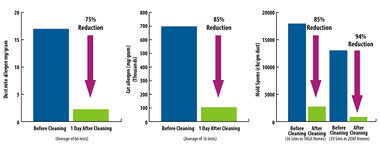HEPA FILTER
What is HEPA filter?
HEPA filters are designed to meet exact specifications in high efficiency commercial or industrial applications. These filters are used where a high degree of cleanliness is required and contaminants must be removed to protect health, products and building interiors. These filters are ideal in a variety of applications including:
- hospitals
- manufacturing plants
- microelectronic component assembly
- negative air machines
- food processing environments.
HEPA (High Efficiency Particle Arresting) filters are the most efficient medium for filtering micron size particles from the air you breathe. A true HEPA filter must capture 99.97% of contaminants 0.3 microns in size. Particles this size are invisible to the naked eye but can be harmful when inhaled. Common allergens that fall into this category include pet allergens, dust mite allergens, mould spores, and pollen.
Household cleaning agents, personal care products, pesticides and paint products are also indoor pollutants. Maintaining cleaner air in your indoor environment reduces allergic reactions and should improve your overall health. The chance of having an allergic reaction to any of the above particles can be reduced by maintaining clean air in your living and work environments.
Why would you need your carpets dry extracted
with HEPA filter?
We are all becoming more aware of the negative impact of ‘dirty air’ on our health. Air Pollution not only triggers allergies and asthma attacks but can cause serious problems for people with heart, lung, and many other medical conditions. Poor air is especially harmful to the very young and very old. Unfortunately, bad air is not just an outdoor problem. According to the Environmental Protection Agency, indoor air is 5 to 10 times more polluted than the air outdoors. Fortunately, we can improve the quality of our indoor air with a regular carpet dry extraction.
You can’t control the air outside, but you can take some simple steps to create a healthier and more natural environment where you spend the greatest amount of time, your own home.
Common allergens "hiding" in the home environment include:
Dust mites: Microscopic arachnids found anywhere there is dust. Just one gram of dust can contain anywhere from 100 to 500 dust mites.
Pet Dander: Dander is small scales of skin that animals shed.
Mould Spores: Microscopic fungal "seeds" that thrive in damp areas of the home, such as the basement, kitchen and bathroom. Carpet and upholstery dust harbours millions of fungal spores.
Pollen: Microscopic reproductive components of flowering plants and trees. They enter the home from outdoors and are a common component of house dust.
ASTHMA
Years of ongoing research indicate that one carpet cleaning with the Host System removes:
Dust mite allergen by 75%
Mold spores by 85%
Cat allergen by 85%

Find out about the latest research on asthma:
Bacteria in Household Dust May Trigger Asthma Symptoms www.nih.gov National Institute of Environmental Health Sciences
In the absence of vaccines, environmental controls aimed at allergen avoidance are currently the best defense against asthma.
STEPHEN A. BRUNTON and RICHARD L. SAPHIR
Stamford Hospital, Stamford, Conn., and Mount Sinai
School of Medicine,
New York, N.Y.
www.hosppract.com
|







